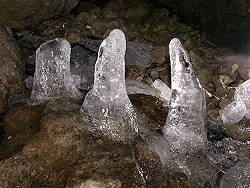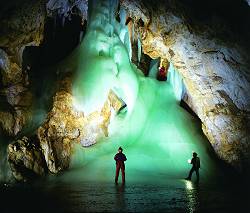Ice Cave
Glacière
An Ice Cave is a cave which contains ice, not a cave formed inside ice those are called Glacier Caves. Ice caves are also called glacières or freezing caverns.


The term Ice Cave is unfortunately used for any underground void connected with ice.
Actually there are four different types of such caverns and only one of them is called Ice Cave.
This page is only about this type of caves, for the others see
 Ice and Caves.
Ice and Caves.
Ice caves may be caves of any type, karst caves, primary caves like lava tubes or tectonic caves. What they have in common is the fact, that there is ice inside the cave. The ice is formed by dripping water and the low temperature of the cave itself. The resulting ice structure look like stalactites and stalagmites, like ice lakes or glaciers.
But it is not that easy: If the cave temperature is below zero, why did the water not freeze inside the rock? The temperature of the rock must be above 0 °C, the cave air below zero. And if this is the case, why ist the cave not completely filled with ice? There must be a change, and a period of ice accumulation is followed by a period of melting ice. There are two different ways how this works:
1. cold trap or ice cellar type: the shape of the cave works as a trap for cold air
Very often, an ice cave has a special shape, a high entrance and no exit at the bottom.
The entrance allows cold air, which is heavier than warm air, to flow down into the cave.
So the cave temperature gets colder than the temperature of the rocks.
In summer the cold air stays inside the cave because of its higher specific weight.
It is the same principle used in supermarket refrigerators to keep the cold inside.
2. dynamic ice caves: outside air blows through the cave
This kind of ice caves works by outside air streaming through the cave and bringing the outside temperature into the cave.
Those caves are generally through caves, caves with at least two entrances.
The average long term temperature outside is also the temperature of the rocks and normally that of the cave.
It must be above 0 °C, otherwise the rock is below zero and water freezes in the cracks and blocks them.
As a result there would be no water and thus no ice inside the cave.
Then there must be cold and warm seasons.
During winter cold air blows through the cave and dripping water from the warmer rocks freezes inside the cave and the ice grows.
During summer warm air blows through the cave and the ice melts.
If more ice grows than melts, the cave fills slowly with ice until it is blocked and the cold air does not blow through the cave anymore.
Otherwise, the ice grows during winter, but melts completely during summer and there is some time without any ice.
Ice caves are very cold, always below 0 °C, the paths are often hard to walk on. It is normally not possible to build concrete paths in the areas with ice, as the ice moves every year and tends to destroy anything in its way. The paths across the ice are often rebuild every year using wooden planks and ropes. Ice caves often have no electric light, as the same problems with moving ice apply to electric installations. Visitors are equipped with headlamps or carbide lamps, the guide additionally use magnesia ribbon, which produces a very bright light when it burns down.
- Examples
 Eisriesenwelt (World of the Ice Giants), Werfen, Austria
Eisriesenwelt (World of the Ice Giants), Werfen, Austria Eiskogelhöhle, Austria
Eiskogelhöhle, Austria Hundalm Eis- und Tropfsteinhöhle, Austria
Hundalm Eis- und Tropfsteinhöhle, Austria Dachstein-Rieseneishöhle, Austria
Dachstein-Rieseneishöhle, Austria Xia Bing Dong, China
Xia Bing Dong, China Wannian Ice Cave, China
Wannian Ice Cave, China Schellenberger Eishöhle, Germany
Schellenberger Eishöhle, Germany Birresborner Eishöhlen, Germany
Birresborner Eishöhlen, Germany Hohenfels-Essinger Eishöhlen, Germany
Hohenfels-Essinger Eishöhlen, Germany Eishöhle bei Roth, Germany
Eishöhle bei Roth, Germany Grotte de la Glacière de Corrençon, France
Grotte de la Glacière de Corrençon, France Grotte de la Glacière, France
Grotte de la Glacière, France Surtshellir-Stefánshellir system, Iceland
Surtshellir-Stefánshellir system, Iceland Raufarhólshellir, Iceland
Raufarhólshellir, Iceland Hellirinn Vidgelmir, Iceland
Hellirinn Vidgelmir, Iceland Narusawa Fuketsu, Japan
Narusawa Fuketsu, Japan Svarthamarhola, Norway
Svarthamarhola, Norway Peştera Ghetarul Focul Viu, Romania
Peştera Ghetarul Focul Viu, Romania Peştera Scarisoara, Romania
Peştera Scarisoara, Romania Kungur ledenica pestera, Russia
Kungur ledenica pestera, Russia Three Eyed Cave, Russia
Three Eyed Cave, Russia Paradana Ledenika Jama, Slovenia
Paradana Ledenika Jama, Slovenia Demanovska L’adova Jaskyna, Slovakia
Demanovska L’adova Jaskyna, Slovakia Dobsinska Ladova Jaskyna, Slovakia
Dobsinska Ladova Jaskyna, Slovakia Silicka Ladnica Jaskyna, Slovakia
Silicka Ladnica Jaskyna, Slovakia Buz Mağarası, Turkey
Buz Mağarası, Turkey Buzluk Mağarası, Turkey
Buzluk Mağarası, Turkey Big Ice Cave, United States of America
Big Ice Cave, United States of America Civil Defense Caves, United States of America
Civil Defense Caves, United States of America Craters of the Moon, United States of America
Craters of the Moon, United States of America Guler Ice Caves, United States of America
Guler Ice Caves, United States of America Mendenhall Ice Caves, United States of America
Mendenhall Ice Caves, United States of America Niter Ice Cave, United States of America
Niter Ice Cave, United States of America Coudersport Ice Mine, United States of America
Coudersport Ice Mine, United States of America Ice Cave and Bandera Volcano, United States of America
Ice Cave and Bandera Volcano, United States of America Ellenville Fault Ice Caves, United States of America
Ellenville Fault Ice Caves, United States of America Shoshone Ice Caves, United States of America
Shoshone Ice Caves, United States of America Trough Creek, United States of America
Trough Creek, United States of America
Literature
- G F. Browne (1865):
Ice-caves of France and Switzerland,
London: Longmans. Green & Co. ix + 315 pp. 8vo.
 George Forrest Browne (1865): Ice-Caves of France and Switzerland
George Forrest Browne (1865): Ice-Caves of France and Switzerland
- Edwin Swift Balch (1970):
Glacieres Or Freezing Caverns,
Johnson Reprint, New York, 1970. 20 cm, 337 pp, HB.
The original edition (1900) is regarded as the rarest US caving book. The author describes ice caves all over the world with a good section on European ice caves. - E S. Balch (1900):
Glacières or Freezing Caverns,
Allen, Lane & Scott. Philadelphia. 337 pp. 8vo.
 Ice cave - Wikipedia (visited: 03-APR-2011)
Ice cave - Wikipedia (visited: 03-APR-2011) Scientific Background, pdf (visited: 02-MAR-2021)
Scientific Background, pdf (visited: 02-MAR-2021)
 Index
Index Topics
Topics Hierarchical
Hierarchical Countries
Countries Maps
Maps Search
Search